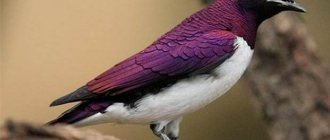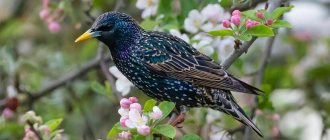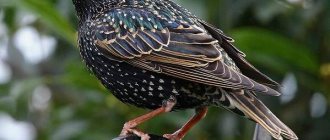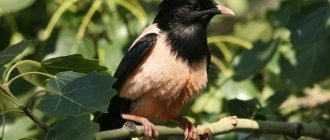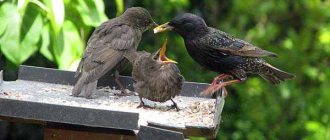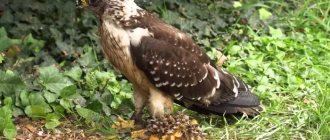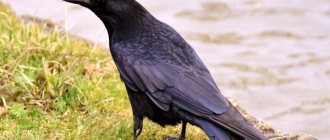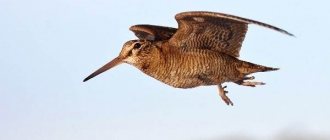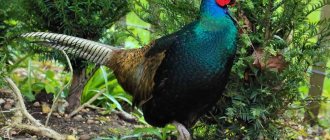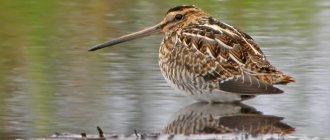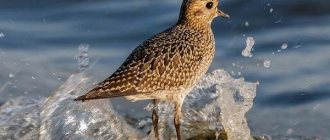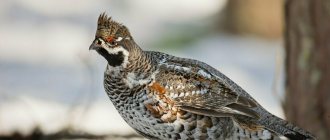Starlings grow up to 22 cm in length and weigh from 50 to 100 grams. Males and females have iridescent green feathers and black wings with green and purple tinges. In winter, against a dark background, white or cream spots appear first on the chest. The shape of the feathers is rounded at the base and serrated towards the tip. Males have long chest feathers. Females have short and rounded feathers.
The paws are reddish-brown, the eyes are dark brown. During the mating season the beak is yellow, the rest of the time it is black. Males have a bluish spot at the base of their bills, while females have reddish-pink spots. Juvenile birds are pale brown until they grow adult feathers, and they have a brownish-black bill.
Where do starlings live?
Birds are found in all biogeographic regions of the world, with the exception of Antarctica. Starlings mainly live in Europe, Asia and North Africa. The natural range is from Central Siberia in the east to the Azores in the west, from Norway in the north to the Mediterranean Sea in the south.
The starling is a migratory bird . The northern and eastern populations migrate and spend the winter in western and southern Europe, sub-Saharan Africa, Egypt, northern Arabia, northern Iran and the plains of northern India.
Did you know?
- The starling is one of the most widespread birds in the world and is classified as Least Concern .
- Ornithologists distinguish 12 subspecies of starlings, which can be distinguished only by the shades of their plumage and subtle differences in size.
- The total area of the starlings' distribution range is almost 38.4 million square kilometers.
- These birds avoid highlands, but are sometimes observed in the Caucasus Mountains at an altitude of up to 1850 meters above sea level. They reach a record height in the Himalayas, where they were met at an altitude of 2500 meters.
- Their number is estimated at 150 million individuals !
- More than half of the global starling population is found in the EU countries and Russia.
- In the southern and western parts of the European continent, starlings lead a sedentary lifestyle, and in the north and east of Europe they migrate to the southern regions in winter.
- The flight speed of starlings is usually 60-80 km/h.
- Sometimes starlings are confused with blackbirds due to the similarity in plumage and size. They can be distinguished by their method of movement: blackbirds jump on the ground, while starlings walk.
- Migratory subspecies can fly up to 1500 km at a time (with short breaks).
What kind of habitat do starlings need?
These are lowland birds. During the breeding season, starlings require nesting sites and fields for feeding. During the remainder of the year, starlings use a wider range of habitats, from open heathland to salt marshes.
Starlings use birdhouses and hollows in trees, as well as crevices in buildings for nests. They are more aggressive than other birds and kill rivals to gain nesting space.
Starlings forage in open habitats such as meadows and pastures. Since they tend to feed and travel in open-air flocks, all members of the group ensure that the predator does not attack and scare it away.
Favorite nesting sites
Birds easily adapt to new conditions and can build nests anywhere. In essence, all kinds of voids suit the starling. Starlings choose tree hollows, building niches, rock cracks, and steep banks as places to build their nests. They are not afraid of close proximity to people: a starling's nest can be found under a balcony or roof of a building. Starlings are also friendly with other birds - their houses can be found in the bases of large nests of birds of prey.
Human-made birdhouses are ideal for starlings. It is thanks to birdhouses that these birds have become so widespread. For centuries, people have attracted starlings into their homes to destroy harmful insects in gardens and vegetable gardens. Starlings settled near stables and barnyards, destroying blood-sucking insects - horseflies, flies, gadflies. This proximity benefited the starlings, and their habitat continues to expand.
How do starlings reproduce?
Starlings build nests from grass, branches and moss, lined with fresh leaves. The leaves are replaced periodically and serve as antibiotics or antifungals.
The breeding season begins in spring and ends in early summer. Its duration varies from year to year. All starlings lay 4 to 7 glossy blue or greenish-white eggs over the course of a week.
Both parents take turns incubating until the chicks hatch. Females spend more time in the nest than males. Chicks hatch after 12-15 days of incubation.
physical characteristics
Photo: John Yunker
Starlings are medium-sized birds . Adults reach a length of about 21.5 cm and weigh between 70 and 100 grams. Both males and females have similar shiny green plumage covering the back, nape and chest. You can often see starlings with black wings that have a greenish and purple tint. In winter, when the tips of the feathers become weathered, a snow-white or cream “speck” appears on a dark black background, mainly on the chest. In the spring, after heavy molting, the plumage of starlings acquires a uniform brown color.
The shape of the feathers is rounded at the base and serrated towards the tip. Both sexes also share similarities in leg color (reddish brown), iris color (dark brown), and seasonal changes in beak color (yellow during mating season, black at other times). In other aspects, sexual dimorphism is pronounced . Males have elongated chest feathers, while females have shortened and small feathers. Males have a bluish spot at the base of their beaks, while females have a red-pink spot. The beak is elongated, pointed and slightly curved downwards.
Photo: Craig K. Hunt
In chicks, the shine on their feathers is not as noticeable as in adults. The chicks also have more rounded wing tips. And unlike the yellow beak of the adult starling, the juvenile has a brownish-black beak all year round.
- Sexual size dimorphism: both sexes are the same
- Body length range: 20-25cm
- Average wingspan: 38 cm
- Average tail length: 6.3 cm
- Body weight range: 70 to 100 grams
How often does reproduction occur?
Starlings may lay more than one clutch in a single breeding season, especially if the eggs or chicks from the first clutch do not survive. Birds living in southern regions are more likely to lay more than one clutch, probably because the breeding season is longer.
Starling chicks are helpless at birth. At first, parents feed them soft animal food, but as they grow older, they expand the range with plants. Both parents feed the young and remove their fecal sacs. The young leave the nest after 21-23 days, but the parents still feed them for several days after that. Once starlings become independent, they form flocks with other young birds.
Relationship with a person
There is a very ambiguous relationship between starlings and humans for several reasons:
- Starlings displace native birds;
- Large flocks of birds interfere with operations and flight safety at airports;
- Birds cause considerable damage to agricultural activities;
- Birds are carriers of dangerous diseases.
In parallel with this, it can be noted that these birds actively destroy pests:
- Locusts;
- Caterpillars;
- Slugs;
- Zhukov;
- Muh;
- Ovodov;
- Horseflies.
It’s not for nothing that man learned to make birdhouses. This is how he attracts birds to his gardens and summer cottages.
Starling behavior
Starlings are social birds that communicate with their relatives all the time. Birds breed in groups and feed and migrate in flocks. Starlings are tolerant of human presence and do well in urban areas.
How starlings communicate with each other
Starlings make loud noises all year round, except when moulting. The songs of males are variable and contain many components. They:
- make trills;
- click;
- whistle;
- creaking;
- chirping;
- gurgling.
Starlings also copy the songs and sounds of other birds and animals (frogs, goats, cats) or even mechanical sounds. Starlings are trained to imitate human voices in captivity. During flight, the starling makes a “queer” sound, a metal “chip” warns of the presence of a predator, and a roar is made when attacking a flock.
Video of a starling singing
Features of character and lifestyle
Photo: Starling in nature
Starlings live in large flocks and can vary in abundance at different times of the year. Sometimes these are very large flocks; during flight they look like a dense sphere, which, as they move, either contracts or expands. This happens without the participation of a clear leader; each member of the flock can change the trajectory of movement, influencing their neighbors. Such aggregations provide protection from birds of prey such as sparrowhawks or peregrine falcons.
In some cities and forest parks, such large concentrations of birds form huge flocks of up to one and a half million individuals, which is a real disaster, since droppings from such flocks can accumulate and amount to up to 30 cm. This concentration is toxic and causes the death of plants and trees. Large flocks can be observed in March on the island of Jutland and on the marshy coasts of southern Denmark. During the flight, they look like a swarm of bees; the local population calls such clusters the black sun.
Such phenomena are observed before birds from Scandinavia begin migrating to their summer habitats in mid-April. Similar flocks, but numbering 5-50 thousand individuals, form in winter in Great Britain at the end of the day. The starling can make various sounds and songs; this bird is an excellent imitator. Starlings repeat the sound even after one listen. The older the bird, the more extensive its repertoire. Males are more skilled at singing and do it more often.
Interesting fact: Female starlings choose partners with a larger set of songs, that is, more experienced ones.
Vocalization consists of four types of melodies that transition into one another without pauses. They can imitate the singing of other birds, the sounds of cars, metal knocks, and creaks. Each sound series is repeated several times, then a new set is sounded. There are repeated clicks between them. Some birds have a repertoire of three dozen songs and one and a half dozen different clicks. The main surge in vocalization is observed during the mating season, when the male tries to attract a partner with his singing, as well as scare away other contenders from his territory, although their singing and screams can be heard at any time of the year.
What do they eat?
Starlings eat a variety of plant and animal products at any time of the year. Young birds eat mainly animal products, such as soft invertebrates. Adults prefer plant foods and obtain them by searching on the ground in open areas with short or sparse vegetation. Starlings sometimes follow farm equipment as it lifts soil. They also feed in intertidal areas, sewage treatment plants, garbage dumps, farms, and livestock feeding areas. They flock to trees where there are ripe fruits or many caterpillars.
Starling food consists of:
- seeds;
- insects;
- small vertebrates;
- invertebrates;
- plants;
- fruit.
Starlings feast on:
- centipedes;
- spiders;
- moths;
- earthworms.
From plant foods they prefer:
- berries;
- seeds;
- apples;
- pears;
- plums;
- cherry
The shape of the skull and muscles allows starlings to penetrate the ground with their beaks or break into solid food and open holes. Birds have binocular vision, see what they are doing and distinguish between types of food.
What role do starlings play in the ecosystem?
The abundance of starlings makes them important prey for small predators. Starlings reproduce quickly, establish new habitats, produce numerous offspring each year, and eat a variety of foods and habitats. They have a significant impact on seed and fruit crops and insect populations. In areas where starlings are not a native species, they displace other birds if they compete with them for nesting sites and food resources.
Singing
Starlings are not only distinguished by their own ringing iridescent trills, which consist of whistling, creaking, hissing sounds, but are also excellent mockingbirds. Perhaps there is no melody that a starling could not reproduce. The song of a thrush, oriole, swallow, lark or jay - the starling can perform any song.
Moreover, the starling can eavesdrop and perfectly copy melodies from the life around him - the croaking of frogs, the barking of dogs, the bleating of sheep.
And at home, a starling can not only be tamed, but also taught to speak short phrases and tongue twisters.
